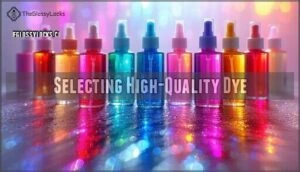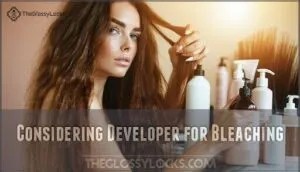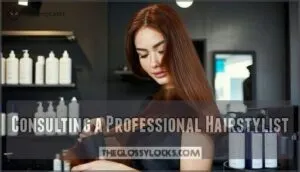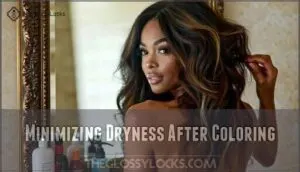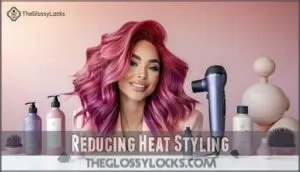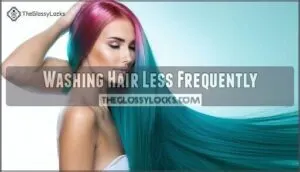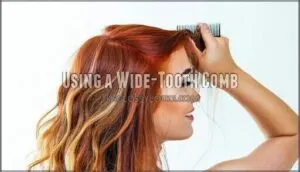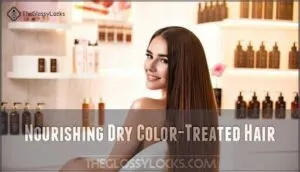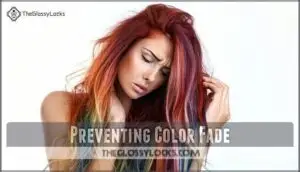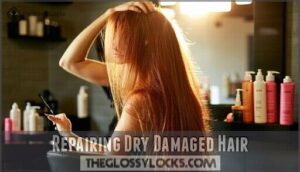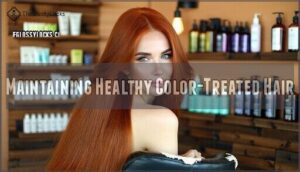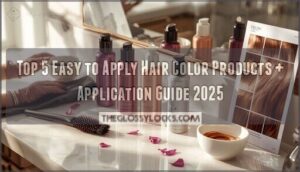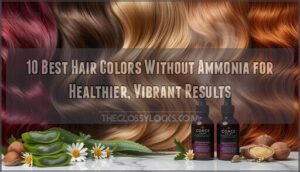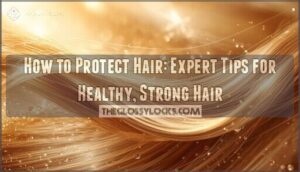This site is supported by our readers. We may earn a commission, at no cost to you, if you purchase through links.

Start by waiting 72 hours before your first wash—this lets the color molecules fully settle into damaged cuticles. Switch to sulfate-free, color-safe shampoos and wash just twice weekly.
Cold water becomes your best friend, sealing cuticles and preventing color bleeding. Deep conditioning treatments twice weekly restore moisture while preserving pigment.
Heat protectants aren’t optional—they’re essential armor against styling damage. Consider professional glosses every six weeks to refresh vibrancy.
The secret lies in treating your hair like delicate silk rather than durable cotton, and following these steps ensures your hair remains vibrant and healthy, with color-safe practices.
Table Of Contents
- Key Takeaways
- Pre-Color Prep for Dry Hair
- Choosing The Right Dye for Dry Hair
- Minimizing Dryness After Coloring
- Maintaining Moisture After Dyeing
- Nourishing Dry Color-Treated Hair
- Preventing Color Fade
- Repairing Dry Damaged Hair
- Styling Dry Color-Treated Hair
- Protecting Color-Treated Hair From Sun
- Maintaining Healthy Color-Treated Hair
- Frequently Asked Questions (FAQs)
- How do you keep colored hair moisturized?
- Is it better to dye your hair while it’s moist or when dry?
- What is the best way to maintain hair color?
- How to treat dry hair from coloring?
- How to prevent dry hair after coloring?
- How to keep your hair moisturized after dying it?
- Can I put conditioner on dry hair before coloring?
- How often should I trim color-treated dry hair?
- How often should I use clarifying shampoo?
- What vitamins help strengthen colored dry hair?
- Conclusion
Key Takeaways
- You’ll need to wait 72 hours after coloring before your first wash—this lets color molecules fully settle while preventing premature fading and moisture loss.
- Switch to sulfate-free shampoos and wash only twice weekly with cool water to seal cuticles and lock in both color vibrancy and hydration.
- Deep condition weekly with protein-rich masks and apply leave-in treatments daily, focusing on mid-lengths and ends where damage concentrates most.
- Always use heat protectants before styling and limit hot tool usage—embrace air-drying and heatless methods to preserve both color vibrancy and moisture levels.
Pre-Color Prep for Dry Hair
Proper preparation transforms dry hair from fragile to resilient before any color treatment begins.
You’ll need to repair existing damage and create an ideal foundation that helps your hair absorb color evenly while minimizing additional stress from chemical processing, which involves complete concepts like repairing and creating a foundation for resilient hair.
Deep Conditioning Before Dyeing
Before diving into color transformation, give your dry hair the moisture boost it desperately needs through Pre Color Care. Deep conditioning treatments work like a shield, improving Hair Porosity and preventing Color Damage by stabilizing Moisture Levels during Dye Preparation.
This step isn’t just prep—it’s insurance for healthier results. Apply a rich deep conditioning mask 24-48 hours before coloring, focusing on mid-lengths and ends where dryness concentrates.
This dry hair care ritual creates a favorable foundation for color protecting while enhancing hair moisturizing and hair hydration.
- Choose treatments with keratin or protein to strengthen weakened strands
- Leave masks on for 20-30 minutes under a shower cap for deeper penetration
- Focus application on damaged areas rather than roots to avoid over-conditioning
- Use lukewarm water to rinse, sealing cuticles and locking in moisture
- Schedule treatments consistently—consistency beats intensity for lasting hair hydration
Trimming Split Ends
Split ends sabotage your color game before you even start. Regular cuts every 6-8 weeks prevent breakage and guarantee even color absorption.
Schedule your hair trim 1-2 weeks before dyeing for superior results.
| Timing | Cut Length | Benefits |
|---|---|---|
| 2 weeks before | 1/4 to 1/2 inch | Removes damage, improves absorption |
| 6-8 weeks after | 1/4 inch | Maintains health, prevents fade prevention |
| Emergency trim | Minimal snip | Split end repair for immediate hair breakage control |
| Maintenance | Regular touch-ups | Supports dry hair care and hair color maintenance |
Avoiding Heat Styling
After trimming those pesky split ends, it’s time to put down the blow dryer and give your hair a break. Heat styling before coloring is like adding insult to injury – your strands need every bit of moisture they can get.
Your hair is begging for mercy—skip the heat and let it heal before you color.
Why stepping away from hot tools matters:
- Thermal damage weakens hair structure – Heat tools strip moisture and create microscopic cracks in your hair shaft, making color absorption uneven
- Cool styling methods preserve natural oils – Air-drying and heatless techniques keep your hair’s protective barrier intact for better dye results
- Heat protectant becomes your best friend – When you absolutely must style, a quality hair serum with thermal protection creates a shield against damage
Embrace styling alternatives like overnight braids, foam rollers, or silk scrunchies for gentle waves. Your hair color maintenance routine will thank you later when the dye takes evenly and your dry hair treatment efforts pay off with vibrant, healthy-looking results.
Repairing Damaged Hair
After skipping heat styling, damaged hair needs strategic repair before coloring.
Think of hair rebuilding like restoring vintage furniture – you need the right approach.
| Hair Heroes | Damage Destroyers |
|---|---|
| Hair masks | Heat styling tools |
| Hair oil | Harsh chemicals |
| Leave-in conditioner | Split ends |
| Hair serum | Dryness |
Focus on breakage fixing with protein treatments and dry hair repair using moisture-rich formulas.
Color restoration works best on healthy strands, so prioritize damage control through consistent hair nourishment before your appointment.
Choosing The Right Dye for Dry Hair
When your hair’s already dry, choosing the wrong dye can turn a bad situation into a disaster.
You’ll want to select high-quality formulations, consider gentler developers, and know when to call in a professional to protect what’s left of your hair’s integrity.
Selecting High-Quality Dye
Choosing the right dye makes all the difference when you’re working with dry hair.
Your hair’s porosity affects how color absorbs, so understanding dye types helps you make smarter choices for fade resistance and hair color preservation.
- Ammonia-free formulas reduce damage by up to 50% while maintaining color vibrancy
- Oil-enriched dyes with jojoba or argan provide dry hair solutions during processing
- Professional-grade pigments offer superior color theory application and longevity
- Bond-repair technology strengthens hair structure while depositing color for enhanced results
For ideal dry hair care, consider using ammonia free dyes to minimize damage and preserve color.
Considering Developer for Bleaching
When bleaching dry hair, your developer choice makes or breaks your results.
Developer types range from 10-volume (gentle lifting) to 40-volume (maximum hair lifting), but dry hair demands caution.
Bleach safety starts with lower volumes—20-volume max for fragile strands.
Color correction often requires multiple sessions rather than aggressive processing.
Remember, toner usage follows bleaching, so don’t rush the process and compromise your hair color maintenance goals.
Consulting a Professional Hairstylist
When you’ve chosen your developer, Hairstylist Consultation becomes your next smart move. Professional Hair Analysis reveals what your strands actually need, not just what you think they do.
A skilled stylist performs Color Correction magic and creates Stylist Recommendations suited to your dry hair reality.
Here’s what quality Salon Services deliver:
- Personalized hair care routine designed for your specific texture and damage level
- Expert color safe shampoo recommendations that actually work with your budget
- Realistic timeline for hair color maintenance tips that fit your lifestyle
- Professional hair color upkeep strategies to maximize your investment
Minimizing Dryness After Coloring
The hours immediately following your color treatment are pivotal for locking in pigments and preventing unnecessary moisture loss.
Smart post-coloring habits can mean the difference between vibrant, healthy-looking hair and dry, faded strands that need constant touch-ups, which relies on healthy-looking habits.
Waiting Before Shampooing
After dyeing your hair, patience becomes your best friend for Color Lock success. The Shampoo Delay isn’t just a suggestion—it’s essential for Cuticle Closure and Pigment Preservation. Those first 72 hours determine whether your color stays vibrant or washes down the drain.
Here’s your waiting game strategy:
- Moisture Retention requires avoiding water completely for 48-72 hours after coloring
- Use dry shampoo to manage oil buildup without compromising fresh pigments
- Sleep on silk pillowcases to prevent friction and color transfer
- Apply leave-in treatments to maintain hydration without rinsing
- Resist the urge to check color payoff with premature washing
Using Color-Safe Shampoo and Conditioner
After waiting 72 hours, you’ll need colorsafe shampoo and conditioner specifically designed for color preservation.
These sulfate free formulas provide gentle cleansing without stripping pigments, while offering moisture lock technology that dry hair desperately needs.
Using a color treated hair product can help maintain the vibrancy and health of your hair.
Product Benefits Look for
Colorsafe products with color enhancing ingredients maintain vibrancy longer than regular dry hair products.
Avoiding Hot Water
Hot water might feel relaxing, but it’s your color-treated hair’s worst enemy.
When you expose your strands to scalding temperatures, you’re basically opening the hair cuticle wide, allowing precious color molecules to escape down the drain. This aggressive approach strips away natural oils and accelerates dryness, leaving your hair looking lackluster.
Cool Water Benefits for your color preservation routine are undeniable. Lower water temperatures help seal the hair cuticle, locking in both moisture and pigment.
Here’s why gentle rinsing transforms your hair color maintenance game:
- Color Preservation: Lukewarm water keeps color molecules trapped inside your hair shaft
- Moisture Retention: Cooler temperatures prevent natural oils from washing away
- Cuticle Protection: Gentle rinsing reduces structural damage and breakage
- Enhanced Shine: Sealed cuticles reflect light better, boosting your hair’s natural radiance
For ideal dry hair advice, finish with the coolest water you can tolerate.
Applying Leave-in Conditioner
After cool water rinses, leave-in conditioner becomes your hair hydration hero. These conditioner types offer daily moisture without weighing down strands, making them perfect for hair color maintenance.
Choose lightweight formulas with hair softening ingredients that boost moisture retention in your hair care routine. Using a leave-in conditioner with heat protectant properties can provide extra benefits for colored hair.
| Product Type | Best For | Key Benefit |
|---|---|---|
| Cream Leave-ins | Thick, coarse hair | Deep hydration |
| Spray Leave-ins | Fine, delicate hair | Lightweight moisture |
| Oil-based | Severely dry ends | Intensive repair |
Apply leavein conditioner from mid-length to ends, focusing where your dry hair advice matters most. This simple step transforms brittle, color-treated strands into manageable, vibrant hair that holds color longer.
Maintaining Moisture After Dyeing
Your freshly dyed hair needs consistent moisture to prevent damage and maintain vibrant color.
You’ll want to establish a protective routine that shields your strands from the common culprits that steal hydration and cause fading, ensuring your hair retains its vibrant color.
Using Heat Protectants
Heat protectants aren’t just styling products—they’re your hair’s best defense against thermal damage. After investing time and money in your color, protecting it from heat styling becomes non-negotiable. These products create a barrier that locks in moisture while preventing heat damage from reaching your hair shaft.
Protectant sprays and hair serums work by coating each strand with protective polymers that distribute heat evenly, preventing hot spots that cause breakage. For color-treated hair already prone to dryness, this protection becomes even more important.
Here’s your heat protection game plan:
- Apply heat protectant spray to damp hair before any styling
- Choose products rated for your styling tool’s temperature (up to 450°F)
- Look for formulas containing silicones and conditioning agents for extra moisture
- Reapply between styling sessions on the same day
- Select thermal protection products specifically designed for color-treated hair
Quality hair color maintenance starts with consistent protection from heat damage. Using a heat protectant is essential for preventing damage and maintaining healthy hair.
Reducing Heat Styling
Breaking up with heat styling tools doesn’t mean sacrificing style.
Instead of cranking up the temperature, try low heat settings or embrace air-drying with texturizing products.
Your color-treated strands will retain moisture better without constant heat damage.
When you must style, always apply heat protectant first—it’s your hair’s bodyguard against thermal trauma.
Washing Hair Less Frequently
Beyond reducing heat styling, your washing schedule plays a vital role in hair color maintenance and moisture balance.
Overwashing strips away natural oils that provide essential hair hydration, leaving color-treated strands vulnerable to dryness and fading. One consideration is that those with oily scalps may experience faster color fading due to excess sebum.
Here’s why reduced frequency washing works:
- Color Preservation – Less water exposure means pigments stay locked in longer
- Gentle Cleansing – Natural oils act as protective barriers against environmental damage
- Moisture Balance – Scalp oils distribute down the hair shaft, combating dryness
- Extended Vibrancy – Fewer wash cycles mean slower color fade and better protection
- Cost Savings – Less product usage while maintaining healthier hair
Using a Wide-Tooth Comb
Wide-tooth combs are your color-treated hair’s best friend for gentle styling and tangle removal.
Unlike regular brushes that cause hair breakage, these comb choices minimize stress on fragile strands.
Start detangling at the ends, working upward—this prevents pulling and preserves your hair color maintenance routine.
Smart detangling tips protect your investment while keeping your dry hair healthy and vibrant.
Nourishing Dry Color-Treated Hair
Color-treated hair demands extra nourishment to combat the inevitable dryness that follows chemical processing. You’ll need targeted treatments that restore moisture while protecting your investment in vibrant color.
Using Deep-Conditioning Masks
Deep-conditioning masks offer your color-treated hair the Moisture Boost it desperately needs while providing essential Damage Control.
These Hair Repair powerhouses work overtime to prevent moisture loss and maintain your Color Lock.
Apply deep conditioning treatments strategically:
- Use hair masks with argan oil and keratin twice weekly for maximum nourishment
- Leave on for 15-30 minutes to maximize Mask Benefits and penetration
- Focus application on mid-lengths and ends where damage typically occurs most
Think of these treatments as insurance policies for your investment in gorgeous color. Understanding deep conditioning methods is vital for achieving the best results and maintaining healthy hair.
Applying Hair Oils
Hair oils act as protective barriers, sealing moisture into your color-treated strands while preventing environmental damage.
These nourishing oils penetrate the hair shaft, delivering essential nutrients that keep your color vibrant and your hair soft.
| Oil Type | Primary Benefit | Best Application |
|---|---|---|
| Argan Oil | Adds shine, reduces frizz | Mid-lengths to ends |
| Jojoba Oil | Mimics natural sebum | Scalp and roots |
| Coconut Oil | Deep moisture penetration | Overnight treatments |
Warm a few drops between your palms before applying to damp hair, focusing on damaged areas where color processing hits hardest.
This simple addition to your hair care routine locks in moisture while creating a protective shield against daily wear, making a significant difference in the health and appearance of your hair with high quality argan hair products.
Avoiding Harsh Chemicals
While oils nourish your strands, protecting them from chemical damage requires avoiding sulfates, parabens, and sodium chloride that strip color and moisture.
Switch to sulfatefree products with natural ingredients for gentle cleansing and color preservation.
Here’s what to avoid for healthier hair:
- Sulfates (SLS/SLES) – Strip natural oils and accelerate color fading
- Parabens – Disrupt pH balance and weaken hair structure
- Sodium chloride – Causes dryness and dulls color vibrancy
- Petrochemicals – Create buildup that blocks moisture absorption
- Harsh alcohols – Dehydrate strands and compromise color protection
Choose color protectant shampoo with plant-based cleansers instead.
Your hair stays vibrant longer when you ditch the harsh stuff.
Using a Humidifier
Moisture-starved dry air acts like a silent thief, stealing hydration from your freshly colored strands.
Running a humidifier creates the perfect moisture balance your hair hydration needs.
This simple hair color maintenance trick prevents frizz, reduces breakage, and keeps your color preservation game strong.
Your dry hair will thank you for this affordable wellness upgrade.
Preventing Color Fade
Your hair color’s worst enemy isn’t time—it’s everything you do after leaving the salon.
The next few weeks determine whether your vibrant new shade stays brilliant or fades into a dull shadow of its former self.
Avoiding Sun Exposure
You can’t shield your color-treated hair from every ray, but smart sun protection prevents devastating UV damage that strips your hair shades.
Think of sunlight as color’s biggest enemy—it breaks down pigments faster than anything else.
- Apply hair sunscreen with SPF 30+ before stepping outside
- Wear wide-brimmed hats to create physical barriers against UV rays
- Seek shade during peak hours (10 AM-4 PM) when sunlight’s most intense
Consistent sunscreen use and strategic shade-seeking dramatically improve color retention.
Using a Color-Depositing Mask
Color-depositing masks revolutionize hair color maintenance by revitalizing vibrancy while delivering deep conditioning benefits.
Your hair craves intensive moisture therapy—color-depositing masks deliver vibrant pigments while healing damage.
These dual-purpose treatments deposit semi-permanent pigments that neutralize brassiness and enhance your color’s richness.
Apply weekly to damp hair, leaving for 5-15 minutes depending on desired intensity.
The nourishing formulas contain argan oil and natural moisturizers that repair damage without harsh chemicals, making them perfect for dry, color-treated hair seeking both protection and nourishment.
Touching Up Roots
New growth doesn’t have to ruin your hair color maintenance game. Smart regrowth timing means scheduling root touchups every 4-6 weeks before roots become obvious.
Here’s your root rescue strategy:
- Use root concealers between salon visits for instant coverage
- Perfect color matching by testing products in natural light first
- Apply touch up roots products only to new growth, avoiding overlap
- Blend carefully at the hairline blending zone for seamless results
- Choose color depositing products that enhance hair color longevity
Professional hair color touchups prevent patchy fading.
Repairing Dry Damaged Hair
Color-treated hair that’s already damaged needs intensive repair to prevent further deterioration and maintain vibrant color.
You’ll want to focus on rebuilding your hair’s structure while protecting the pigments you’ve invested in, since damaged hair loses color faster than healthy strands.
Using a Hair Repair Mask
In the context of repairing damaged color-treated hair, hair repair masks deliver the moisture boost your strands desperately need.
These nourishing masks contain hydrating oils like argan and coconut that penetrate deep into the hair shaft, providing essential damage fix while helping with color lock.
Apply weekly for maximum mask benefits and noticeable hair repair results.
Applying a Hair Serum
Applying hair serum effectively transforms damaged, color-treated hair into silky strands that feel healthier. Serum benefits include moisture retention, frizz control, and enhanced shine—exactly what your dry hair craves after coloring.
Choose serum types based on your hair texture: lightweight formulas for fine hair, richer oils for coarse strands. Serum ingredients like argan oil, keratin, and silicones create a protective barrier while boosting hair moisture.
Application tips for maximum hair protection:
- Apply to damp hair for better absorption
- Focus on mid-lengths and ends, avoiding roots
- Use 2-3 drops for short hair, more for longer lengths
- Distribute evenly with fingers or wide-tooth comb
- Layer under dry shampoo on non-wash days
This hair care tips approach seals cuticles and prevents further damage while maintaining your color investment.
Avoiding Heat Styling Tools
Heat styling tools wreak havoc on color-treated dry hair, accelerating damage and fading.
Embrace Heat Tool Alternatives like air-drying, braiding damp hair for waves, or using foam rollers.
These Cool Styling Tips preserve your color while reducing breakage.
When heat’s unavoidable, apply Thermal Protection products first.
Your Gentle Hair Care routine should prioritize heat protectants over hot tools for lasting hair color maintenance tips.
Getting Regular Trims
Every damaged strand tells a story, and hair trims are your plot twist toward healthier locks. Schedule cuts every 6-8 weeks to maintain ideal Hair Growth Patterns and prevent Split End Prevention issues from spreading.
A good start involves understanding causes of damaged hair.
Consider these essential benefits:
- Cuticle Care improves when damaged ends are removed
- Frizz Reduction occurs naturally with healthier hair structure
- Hair color maintenance stays vibrant longer on trimmed strands
- Dry shampoo works better on well-maintained hair lengths
Regular hair care tips include discussing your color-treated needs with stylists who understand how hair cuticles respond to chemical processing.
Styling Dry Color-Treated Hair
Styling color-treated hair requires a delicate balance between maintaining your vibrant hue and protecting your already-vulnerable strands.
The key lies in choosing gentle products and techniques that won’t strip your color while keeping your hair healthy and manageable.
Using a Sulfate-Free Shampoo
Sulfate alternatives transform your hair care routine by eliminating harsh detergents that strip color and moisture.
While lather absence might feel unusual initially, these gentle formulas excel at color retention and scalp health.
Your hair dryness decreases substantially with nourishing shampoo options that preserve pigments while cleansing effectively.
| Sulfate Shampoo | Sulfate-Free Shampoo |
|---|---|
| Creates rich lather | Minimal foam production |
| Strips natural oils | Preserves moisture barrier |
| Accelerates color fade | Extends color vibrancy |
These ingredient benefits include amino acids and botanical extracts that strengthen hair structure.
Hair color tips from professionals emphasize choosing formulas specifically designed for color maintenance, ensuring your investment in salon treatments lasts longer while maintaining healthy strands.
Applying a Leave-in Conditioner
Your hair’s thirsty strands deserve this game-changing step. Leave-in conditioner acts as your color’s bodyguard, delivering continuous hydration and protection throughout the day.
Here’s your application techniques playbook:
- Target the ends first – they’re most damaged and need extra leave-in treatments
- Work upward to mid-lengths – avoiding roots prevents greasiness
- Use damp hair – enhances absorption for maximum Leave-in Benefits
This Product Selection creates a protective barrier that locks in moisture while preserving your color-treated hair’s vibrancy.
Avoiding Hot Tools
Your styling routine doesn’t need scorching temperatures to achieve stunning results.
Air-dry methods and heatless hairstyles like braids or rollers protect your color investment while preventing hair damage.
When heat’s unavoidable, use thermal protectants and low-heat styling settings.
These damage prevention strategies maintain hair health and extend your color’s vibrancy—your strands stay hydrated and gorgeous.
Protecting Color-Treated Hair From Sun
Sun exposure is your color’s biggest enemy, breaking down pigments faster than you can say "faded highlights."
You’ll need strategic protection to keep those vibrant tones looking fresh between salon visits.
Using a Hair Sunscreen
Sun exposure isn’t just tough on your skin—it’s wreaking havoc on your color-treated hair too.
Hair sunscreen creates a protective barrier against harmful UV rays that break down color molecules.
Look for lightweight formulas with zinc oxide or antioxidants that won’t weigh down your hair shafts.
Apply these sunscreen ingredients daily, not just during beach days, for ideal hair color protection and longevity.
Wearing a Hat
Beyond hair sunscreen, donning the right hat transforms you into your hair’s personal bodyguard against UV damage.
Your hat choice directly impacts your hair color protection strategy and overall hairstyle preservation.
Consider these hat essentials for maximum hair color care:
- Hat Material matters: Cotton and straw offer breathability while providing solid UV protection for color-treated strands
- Weather Protection extends beyond sunny days: Wind and humidity also threaten your hair color fading, making hats your year-round allies
- Hat Cleanliness prevents buildup: Regular washing eliminates oils and products that could transfer to your hair
Choose Occasion Appropriate styles that complement your look while delivering serious sun exposure defense.
Wide brims create the best shield for your locks.
Avoiding Prolonged Sun Exposure
While hats provide excellent protection, limiting your time in direct sunlight offers another layer of defense against UV hair damage.
Extended sun exposure accelerates color fading and strips essential moisture from already-dry strands. Plan outdoor activities during cooler hours when possible, and seek shade regularly to prevent cumulative damage.
| Time of Day | UV Intensity | Hair Risk Level |
|---|---|---|
| 6-8 AM | Low | Minimal damage |
| 10 AM-2 PM | Peak | High color fade risk |
| 2-4 PM | High | Moderate damage |
| 4-6 PM | Medium | Low to moderate |
| After 6 PM | Low | Minimal concern |
This proactive approach helps maintain vibrant color while preserving your hair’s natural hydration levels.
Using a Color-Protecting Spray
Color-protecting sprays are your hair’s bodyguards against UV damage.
These specialized products create an invisible shield, preserving color vibrancy while defending against environmental stressors. Apply before sun exposure for maximum effectiveness.
Top Color-Protecting Sprays:
- Bumble and bumble Hairdresser’s Invisible Oil – Lightweight UV protection with nourishing oils
- Moroccanoil Protect & Shine – Heat defense up to 430°F with color longevity benefits
- Aveda Thermal Dry Remedy – Plant-based formula for damaged, colortreated hair
- Redken Pillow Proof – Multi-tasking spray with ingredient benefits for hair color care
- Kerastase Dernière Richesse – Professional-grade color preservation technology
Maintaining Healthy Color-Treated Hair
Maintaining healthy color-treated hair requires consistent care that balances moisture retention with color preservation.
You’ll need to establish a routine that nourishes your hair while protecting your investment in professional coloring services, which is crucial for maintaining the healthy look of your hair.
Using a Color-Safe Shampoo
Transform your hair care routine by switching to sulfate-free shampoos that preserve your color investment.
These sulfate alternatives maintain proper pH balance through gentle cleansing agents.
Focus your application technique on the scalp rather than lengths.
Reduce shampoo frequency to 2-3 times weekly for ideal colored hair care.
Always follow with a color-safe conditioner for complete protection and moisture retention.
Eating a Balanced Diet
Nourishing your color-treated hair starts with nutrient intake that supports hair health from within.
Your protein sources—like lean meats, eggs, and beans—provide essential building blocks for strong strands. Hydration importance can’t be overstated; water delivers nutrients to follicles while maintaining moisture balance.
Consider these dietary priorities for enhanced hair resilience:
- Protein foundation: Aim for 20% of daily calories from quality protein sources
- Healthy fats: Include omega-3s from salmon and walnuts for shine and strength
- Vitamin boost: Focus on biotin, vitamin C, and iron-rich foods for color retention
- Strategic hydration: Water-rich foods like cucumber support nutrient delivery
A healthy diet beats vitamin supplements alone—your hair reflects what you eat daily.
Frequently Asked Questions (FAQs)
How do you keep colored hair moisturized?
Wondering why your color-treated strands feel like straw? Use sulfate-free shampoos, deep condition weekly, wash with cool water, apply leave-in treatments, and limit heat styling to preserve moisture and vibrancy.
Is it better to dye your hair while it’s moist or when dry?
You’ll want to dye your hair when it’s dry. Professional colorists always apply dye to dry strands because moisture dilutes the formula, creating uneven color results and poor pigment absorption.
What is the best way to maintain hair color?
Use sulfate-free, color-safe shampoo and conditioner, wash 2-3 times weekly with cool water.
Wait 72 hours after coloring before first wash, apply weekly deep treatments.
Protect from heat styling and UV exposure.
How to treat dry hair from coloring?
An ounce of prevention’s worth a pound of cure—deep condition weekly with sulfate-free products.
Limit heat styling, wash less frequently, and always use cool water to seal cuticles and lock in moisture, following the idea that an ounce of prevention’s worth a pound of cure.
How to prevent dry hair after coloring?
Pre-treatment conditioning protects strands from chemical damage. You’ll want to use sulfate-free products, wait 72 hours before washing, apply deep masks weekly, and minimize heat styling to maintain moisture.
How to keep your hair moisturized after dying it?
Ironically, dying your hair often kills its moisture, but you can revive it.
Apply weekly deep conditioning masks, use sulfate-free shampoo, wash less frequently with cool water, and seal ends with nourishing oils.
Can I put conditioner on dry hair before coloring?
Applying conditioner to dry hair before coloring isn’t recommended.
It creates a barrier that prevents color from penetrating properly, resulting in uneven coverage and patchy results.
Skip pre-conditioning for ideal dye absorption.
How often should I trim color-treated dry hair?
Regular trims every 6-8 weeks will prevent split ends from traveling up your color-treated strands, keeping your hair healthier and helping your color look more vibrant and even.
How often should I use clarifying shampoo?
Use clarifying shampoo sparingly on color-treated dry hair—no more than once monthly.
These powerful formulas strip both color pigments and essential moisture, accelerating fade and increasing dryness in already vulnerable strands, which can lead to significant damage if not used with caution.
What vitamins help strengthen colored dry hair?
Getting the inside track on vitamins for colored dry hair starts with biotin, vitamin D, and iron supplements. You’ll need B-complex vitamins, vitamin E, and omega-3s to strengthen hair.
Conclusion
Rome wasn’t built in a day, and neither is healthy, vibrant color-treated hair.
You’ve now got the complete toolkit for mastering hair color maintenance tips for dry hair.
From pre-color preparation to daily styling routines, each step works together to preserve your investment.
Remember, consistency beats perfection—following these expert-backed strategies will transform your dry, color-treated hair into the lustrous locks you’ve always wanted.
Your future self will thank you.
- https://www.livingproof.com/blogs/hair-101/colored-hair-tips
- https://blog.wella.com/us/how-to-care-for-colored-hair
- https://baskandbloomessentials.com/blogs/news/how-to-moisturize-colored-curly-hair
- https://burmanandco.com/blog/hair-color-maintenance-color-treated-hair-tips/
- https://www.linkedin.com/pulse/top-mistakes-avoid-when-shampooing-colored-giqcf

